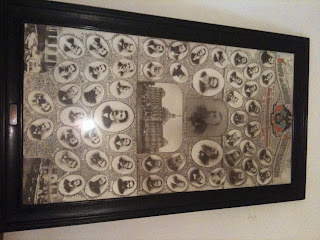On December 29, we made an excursion to Pretoria. It was only about 40 minutes from the B&B along an excellent motorway. Although I had no recollection of Pretoria as such, I had memories of lion statues and being photographed sitting on one, and was sure they were at the Union Buildings, and a must check-it out for me.
We went first to the new Freedom Park overlooking the city. http://www.freedompark.co.za/. It is beautifully designed to fit around the hill it is built on, one can hardly tell from a distance there is a large building. The 200 slim silver poles surrounding the site, represent reeds. All the walls are built with slates of different hues. Very labor intensive to construct. Steps wind around taking the visitor to different areas. We saw one component of the memorial, Sikumbuto, commemorating the conflicts that shaped South African history. Not all the areas are are complete, but enough is to see how this is going to be a place South Africans will want to take their children to learn about their heritage. There is a still body of water,Tiva, reflecting peace, tranquility and serenity. The Eternal Flame sits in a basin on the edge of a section of the building.
In the far distance across the valley on another hill, is the Voortrekker Monument commemorating the Boers trek north from the Cape. From the Freedom Park we went into downtown Pretoria to the Union Buildings to check out the lion statues. There is a spectacular view of the city from the magnificient Union Buildings built on a hill and completed in 1913, but no lions! We walked all around in the heat, my photogenic mind was searching frantically for locations, but nothing came up. It was well worth the visit for the view and the buildings. I was disappointed but I had one more place to check out.
We cotinued on down into the city to visit the Paul Kruger House, President of the old ZAR ( Zuid Afrikaanse Republiek). http://www.southafricaholiday.org.uk/places/m_g_krugerhousemuseum.htm.
The museum bears witness to the forceful personality of Kruger, who was the leader of a small Boer republic in Southern Africa that was engaged in a struggle against British Imperialism. The house is a fascinating glimpse into European living in the late 1800's. Most of the objects and furniture are original to the house which makes it so interesting. Much of it came from Europe to Lourenzo Marques (now Maputo) by boat, then brought overland by train. Kruger had the rail line built from Pretoria to Lorenzo Marques. There was no way the ZAR could get goods from the coast, as Britian had a blockade from Capetown up the East Coast. This was one of the first houses in Pretoria to be electrified. Two offices, one for Kruger's private secretary, with one of the first telephones to be installed in Pretoria in 1891, the other used by Kruger himself. In the garden there is a large barn that houses a trek wagon, and Kruger's State Coach. Many objects that were given to Kruger as tokens of sympathy are displayed and showed the international support for the Boers' struggle for independance during the Anglo-Boer war, 1899-1902. Also in the garden is Kruger's State Railway Coach which he used on official visits and political campaigns. After the British won the war, Kruger went into exile in Europe.
We were ready for lunch after the visit, and went on to Church Square in the centre of town, where the market used to be. I was beginning to realise the difference between Pretoria and Johannesburg. Pretoria, although the Executive capital of South Africa (Capetown is the Legislative capital, and Bloemfontein is the Judicial capital), has still a small-town feel and with Afrikaans roots. Johannesburg is beautiful and brash, reminicent of the gold and diamond rushes. Lots of money to be made, attracting all types.
We had lunch at the Cafe Riche, an establishment that originally opened in 1904. It reopened in 1994, and has an excellent reputation, and is very popular and well-loved, according to the postcards sent by clientele in far-away places. The food was excellent, nothing fancy, but well prepared and presented. I tried the dessert "Koeksisters" -dough deep-fried then soaked in a sugary liquid. Sherry or Grand Marniere would have added some flavor, it was rather bland.
After lunch we walked around the square which has imposing buildings surrounding the statue of Paul Kruger in the center. They include the Old Capitol Theatre, The tudor Chambers and the General Post Office, and the turreted Palace of Justice which was the scene of the most famous trial in political history in South Africa, the Rivonia Trial. During this trial Nelson Mandela and other prominent liberation figures were charged with treason and subsequently incarcerated.
Further along from the square were the Botanical Gardens where we stopped for a few minutes for Zoe to play in the playground. The park was designed in the early 1900s - beautiful lawns, ponds, plantings and a bandstand. On the farther side of the park is the Melrose House http://www.melrosehouse.co.za/ where in 1902 the treaty between the Boers accepting the peace conditions with loss of independence, and the British, was signed by a delegation of 10 Boers including Paul Kruger.
Unfortunately, due to the holidays, the house was closed. I was disappointed as the house, beside being of great historical significance, is a Victorian mish-mash of different styles - wide verandas for sitting in the afternoons, and of course, beautiful lawns and flower beds.
We tried to get into the Transvaal Museum, but were refused as they were getting ready to close. It had been a very hot day, so we drove back to Sandton for a swim and a cool down.





No comments:
Post a Comment